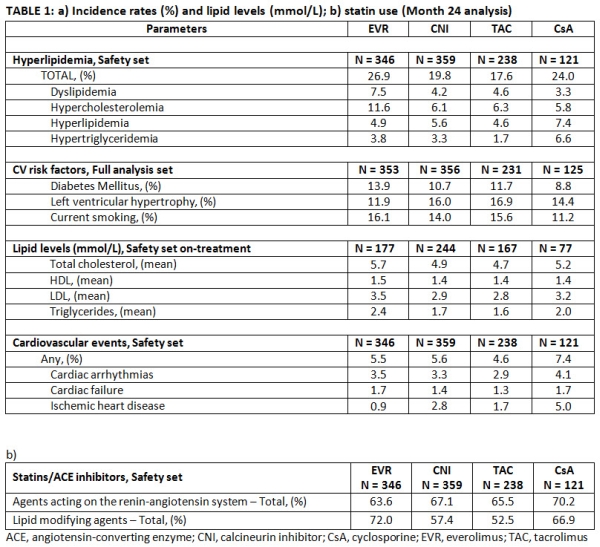Influence of Lipid Levels on Cardiovascular Events After Early Conversion from Calcineurin Inhibitor to Everolimus: 24 M Analysis of the ELEVATE Study.
1ELEVATE study group, Berlin, Germany
2Novartis pharma AG, Basel, Switzerland
3Novartis Pharmaceutical Corporation, East Hanover, NJ.
Meeting: 2016 American Transplant Congress
Abstract number: 12
Keywords: Immunosuppression, Kidney transplantation, Lipids, Risk factors
Session Information
Session Name: Concurrent Session: Cardiovascular Complications in Kidney Transplantation
Session Type: Concurrent Session
Date: Sunday, June 12, 2016
Session Time: 2:30pm-4:00pm
 Presentation Time: 3:42pm-3:54pm
Presentation Time: 3:42pm-3:54pm
Location: Room 304
Background: Immunosuppressive therapies are probably the most important cause of hyperlipidemia post-renal transplantation (RTx). Lipid abnormalities represent important biomarkers for cardiovascular (CV) risk. Here, we report results from the ELEVATE study on the effect of early CNI withdrawal and introduction of everolimus (EVR) vs calcineurin inhibitor (CNI) control on different lipid parameters and CV events.
Methods: ELEVATE (NCT01114529) is a 24 M, open-label, multicenter study, in which de novo RTx recipients (R) were randomized at 10-14 weeks post-Tx to receive EVR (n=360; C0 6-10 ng/mL) or to continue standard CNI regimen (n=357; C0: TAC 5-10 ng/mL or CsA 100-250 ng/mL). Patients received steroids as per center practice. Lipid parameters, total cholesterol (TC), high-density lipoprotein (HDL), low-density lipoprotein (LDL) and triglycerides (TG) were assessed at different time points throughout the study. CV events were captured during the study in the eCRF.
Results: At M24, incidence of hyperlipidemia was higher in EVR vs CNI arm (26.9 vs 19.8%). Within CNI arm, higher incidence of hyperlipidemia was observed with CsA vs TAC (7.4 vs 4.6%). Incidence of hyperlipidemia increased from randomization to M6, before decreasing for the remainder of the study. The mean TC, LDL and TG values were higher in EVR vs CNI arm. Incidence for CV events was comparable between EVR and CNI (5.5 vs 5.6%), and between EVR and TAC (5.5 vs 4.6%). Within the CNI arm, incidence of CV events was higher for CsA vs EVR (7.4 vs 5.5%) (TABLE 1a). Statin use was comparable between arms (TABLE 1b).
Conclusion: Although lipid abnormalities were more common in the EVR vs the CNI arm, CV events remained comparable between both treatment arms. These findings suggest no correlation between elevated lipid levels and the incidence of CV events in patients who converted 3M after RTx from CNI to EVR, although longer follow-up is warranted.

CITATION INFORMATION: van der Giet M, de Fijter J, Oppenheimer F, Toselli L, Russ G, Lopez P, Aguilar J, Bernhardt P, Wang Z, Cruzado J, Holdaas H. Influence of Lipid Levels on Cardiovascular Events After Early Conversion from Calcineurin Inhibitor to Everolimus: 24 M Analysis of the ELEVATE Study. Am J Transplant. 2016;16 (suppl 3).
To cite this abstract in AMA style:
Giet Mvander, Fijter Jde, Oppenheimer F, Toselli L, Russ G, Lopez P, Aguilar J, Bernhardt P, Wang Z, Cruzado J, Holdaas H. Influence of Lipid Levels on Cardiovascular Events After Early Conversion from Calcineurin Inhibitor to Everolimus: 24 M Analysis of the ELEVATE Study. [abstract]. Am J Transplant. 2016; 16 (suppl 3). https://atcmeetingabstracts.com/abstract/influence-of-lipid-levels-on-cardiovascular-events-after-early-conversion-from-calcineurin-inhibitor-to-everolimus-24-m-analysis-of-the-elevate-study/. Accessed December 13, 2025.« Back to 2016 American Transplant Congress
